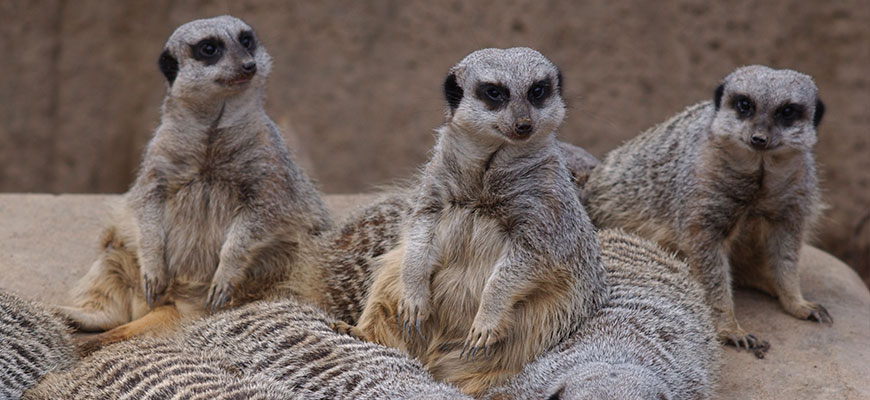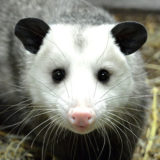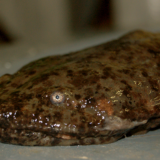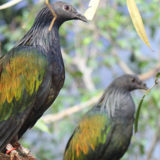RANGE
Southern Africa: Southwestern Angola, Namibia, Botswana and South Africa
HABITAT
Dry, open country or semi-arid plains, commonly with hard or stony ground, savanna, to bush areas. Meerkats generally avoid wooded areas and dense vegetation, preferring scrub areas.
SIZE
Overall Length: Head to tip of tail averages 20 inches.
Ranges: Body Length: 10 – 14 inches
Tail Length: 7 – 10 inches
Overall Weight: Averages 2 pounds
Ranges: Males: 1.4 – 1.75 pounds Females: 1.36 – 2.1 pounds
REPRODUCTION
Gestation: Approximately 11 weeks (75 – 77 days) Meerkats are sexually mature at around 1 year of age. During courtship, males approach females and generally bites at the females neck which will aid in bringing her into cycle and make aggressive females more receptive. Females will refuse males until this process takes place. During copulation the males grab hold of the females with their fore legs and the neck biting ends.
Young meerkats are born blind and hairless with litter sizes ranging from two to five young, averaging around four. Eyes will generally open after 12 – 14 days. Weaning of the young is relatively quick, with the young receiving their first solid food from the mother at about 3–6 weeks. Mothers will leave the babies in the care of other adults while hunting for food.
Meerkats live in close-knit, social colonies and all play a role in the raising of the young. The mother will introduce young to unfamiliar new foods by running around with it in her mouth and encouraging the young to try and grab it from her. Meerkat young resemble the adults by around 2 months of age.
DIET
Wild: Omnivorous. Insects, spiders, snails, scorpions, rodents, ground-nesting birds and their eggs, lizards, snakes, bulbs and roots of certain plants.
Zoo: Insect — Meal worms, Crickets, Dried Food
BEHAVIOR
- Meerkats among the most sociable of all the mongooses, living in colonies from 5–30 (averaging 10–15 animals). Colonies consist of several families living together in tight-knit groups in which individuals have special duties that benefit the group as a whole.
- Meerkats are burrowing animals and the colonies interconnecting burrows at times can reach depths of as much 10 feet. These burrows are often shared with other animals, such as ground squirrels and the yellow mongoose.
- Meerkats are diurnal animals, usually actively foraging throughout the day in pairs or small groups near the colonies system of burrows. Members of the group stay alert at all times for possible threats such as jackals or birds of prey.
- Meerkats can often be seen standing straight up on their hind legs, using their tails to balance like a tripod, keeping an eye open for possible threatening situations. Some individuals take on the task of standing guard for the rest of the group while they are foraging, often taking position in the branches of trees or shrubs or on rocks and barking out warnings at the first sign of danger. This upright posture is also assumed by individuals when sunning themselves or guarding young while the parents are out collecting food.
- When danger is signaled by a member of the colony, the meerkats make a dash for the nearest burrow. Meerkats have been observed to demonstrate an elaborate set of signals that appear to have specific meanings as to the nature of the threat at hand. An upright tail, for instance, might signal a threat from overhead; such as the sighting of vulture or hawk.
- Meerkats have a very keen sense of smell and excellent eyesight, which are major aids in the detection of food or the spotting of potential predators.
- Meerkats have other strategies for defense against rival groups or to ward off predators. When a confrontation occurs, meerkats will begin digging frantically, throwing clouds of dust into the air to try and distract the rival group or threatening predator. Another strategy that has been observed when a group feels threatened, is the entire group will advance in a pack towards the aggressor or aggressors, with hair bristling and stage a series of mock attacks to try and scare away the intruder. During such confrontations, meerkats will make themselves appear as large and as fearsome as possible by arching their bodies, stretching out their legs and holding their tails erect. The entire group will then advance on the intruder, continuously leaping into the air and growling aggressively. More aggressive members of the meerkat group may even bite the intruder.
- When a meerkat is put on the defensive, it will throw itself back with teeth bared and claws stretched out towards its attacker.
- Meerkats are powerful diggers and their sharp claws and strong legs make formidable weapons against an attacker.
POINTS OF INTEREST
- The social organization within a meerkat community is very close, with each member taking up various roles or assigned duties to benefit the entire group. Members work cooperatively in roles as sentries, hunters, baby sitters or teachers.
- Sentries are often seen standing in a upright posture, balancing on their hind legs and tail, scanning the horizon and the sky for possible danger.
- Hunters will move in groups in search of food.
- Meerkats have a keen sense of smell aiding them greatly when digging for food or foraging along the surface. When a meerkat has prey in sight, it will strike the prey with its front paws first before killing it with a bite. The meerkat will tear the prey into pieces before carrying back the remains to share with others in the burrow.
- Meerkats are known to attack and kill scorpions and poisonous snakes for food and are believed to be immune to their poisons.
- Meerkat teachers will show juveniles how to hunt for food and baby sitters remain near the burrow to care for the young while mothers are out hunting.
- Meerkat groups communicate using a wide range of body signals, as well as numerous types of calls ranging from chirps, growls, trills and barks, depending on the situation.
STATUS
Common throughout their range. Does not appear to be in danger of extinction, however loss of its habitat is believed to have reduced their numbers. Further erosion of their habitat could change the meerkats status in a short time.
REFERENCES
- Grzimek’s Animal Life Encyclopedia, Dr. Dr. h.c. Bernard Grzimek, Editor-in-chief, 1975
- Walker’s Mammals of the World, Ed. 5, Vol. II, Ronald M. Nowak, 1991
- Macmillan Illustrated Animal Encyclopedia, Edited by Dr. Philip Whitfield, 1984
- Wildlife Fact File, IMP BV/IMP INC. , 1991
- The Addo Gang: My Time Among Meerkats, Africa-Environment & Wildlife, Vol. 5, No. 5, 1997, Daniel Christen





